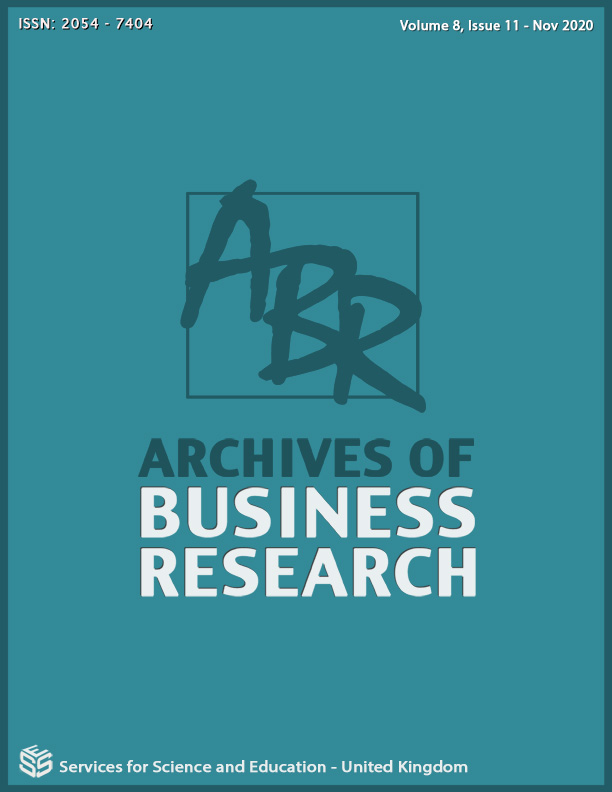CSR INITIATIVES: THE PREDICTOR OF FINANCIAL PERFORMANCE IN ENERGY SECTOR
DOI:
https://doi.org/10.14738/abr.811.9207Keywords:
Corporate Social Responsibility, Financial Performance, Energy SectorAbstract
The purpose of this research was to investigate the relationship between Corporate Social Responsibility (CSR) and the financial performance for publicly-traded firms operating in the energy sector. The energy sector has a unique role to play in global CSR efforts because of the size of the firms within that industry, the impact on the environment, and the operational risks that come with energy production. Previous research has been conducted on the relationship between CSR engagement and financial performancein various contexts, but this research has shown mixed outcomes– in some cases there is a positive relationship between CSR and performance while in other studies the research is non-existent or marginal. Thus, the research question for this study addresses a significant gap in the understanding of this topic by exploring the relationship between CSR and firm performance in a contextualized setting of the energy sector. The dependent variable was a series of three financial metrics –returnon assets (ROA), return on equity (ROE), and EBITDA. This study looked into convenience sampling method and the population in this study was employees who were currently employed in an energy sector company in Malaysia.
References
Bowen,H. R. (1953).Socialresponsibilities of thebusinessman. NewYork: Harper.
Brammer, S., Millington, A., &Rayton,B. (2007).The contribution of corporate social responsibility to organizational commitment. International Journal of Human Resource Management, 18(10),
Carroll, A. B.(1979). A three-dimensional conceptual model of corporate performance.
Academy of Management Review, 4(4).
Dahan, N., Doh, M.,&Raelin, J. (2015). Pivoting the role of government in the business and society interface: A stakeholder perspective. Journal of Business Ethics, 131(3)
Dam,L.(2008). Corporate social responsibility and financial markets.(Doctoral Dissertation). University of Groningen. Retrieved from http://hdl.handle.net/11370/147efa18-f534-4842-8923-ec260395c8a1
Dimson, E., Karakas, O.,&Li, X., (2012). Activism in corporate social responsibility.
Proceedings from the Annual Meetings of the Financial Management, Europein Istanbul, Turkey.
Fatemi, A.,Fooladi,I.,& Tehranian,H. (2015). Valuation effects of corporate social responsibility. Journal of Banking & Finance, 59.
Freeman, R. E. (1984).Strategic management: A stakeholder approach.Boston, MA: Pitman.
Freeman, R. E. (2010).Managing for stakeholders: Trade-offs or value creation.Journal of Business Ethics, 96..
Friedman, M.(1970, September 13).The social responsibility of business is to increase its profits. New York: Times Magazine.
Hawn, O.,& Ioannou,I.(2016). Mind thegap: Theinterplaybetween external and internal actions in the caseof corporate social responsibility.Strategic ManagementJournal, 37(13).
Hong, H.,Kubik, J.D., Scheinkman, J.A. (2012).Financial constraints on corporate goodness. National Bureau of Economic Research Working Paper 18476.
Husted, B. W., &Sousa-Filho, J. M. (2016).The impact of sustainability governance, country stakeholder orientation, and country risk on environmental, social and governance performance. Journal of Cleaner Production.
Isukul, A.(2013). The use of multiple methods of engagement: A case study of foreign
& colonial investments. (Doctoral Dissertation). NorthumbriaUniversity, England.
Klein, P. (2012). Defining the social purpose of business. Forbes Online. Retrieved from https://www.forbes.com/sites/csr/2012/05/14/defining-the-social-purpose-of-business/#14e2188b1cac.
Laplume,A. O., Sonpar,K. &Litz, R. A. (2008). Stakeholder theory: Reviewing a theory that moves us. Journal of Management 34(6).
Margolis, J.D., Elfenbein, H.A., Walsh, J.P. (2012). Does it pay to be good and does it matter? A meta-analysis of the relationship between corporate social and financial performance. Universityof Michigan WorkingPaper.
Retrievedfrom https://www.hks.harvard.edu/m-rcbg/papers/seminars/margolis_november_07.pdf
Michel, N., &Buler, S. (2016). Maximizing the benefits of corporate social responsibility. How companies can derive benefits from corporate social responsibility.EuropeanScientific Journal, 1.
Nemetz, A. (2015). A global investigation of government and community stakeholder influences on large company engagement in sustainability. International Journal of Business and Management, 10(2).
Peloza, J. (2009). The challenge of measuring financial impacts from investments in corporate social performance. Journal of Management, 35(6).
Poddi, L., & Vergalli, S. (2009). Does corporate social responsibility affect the performance of firms? In Coalition Theory Network Workshop. Maastricht, The Netherlands.
Porter, M. E., & Kramer, M. R. (2011). Creating shared value: How to reinvent capitalism and unleash a wave of innovation and growth. Harvard Business Review, 89(1).
Ritchie,L. (2012). Individual stress, collective trauma, and social capital in the wake of the Exxon Valdezoil spill.Sociological Inquiry, 82(2).






